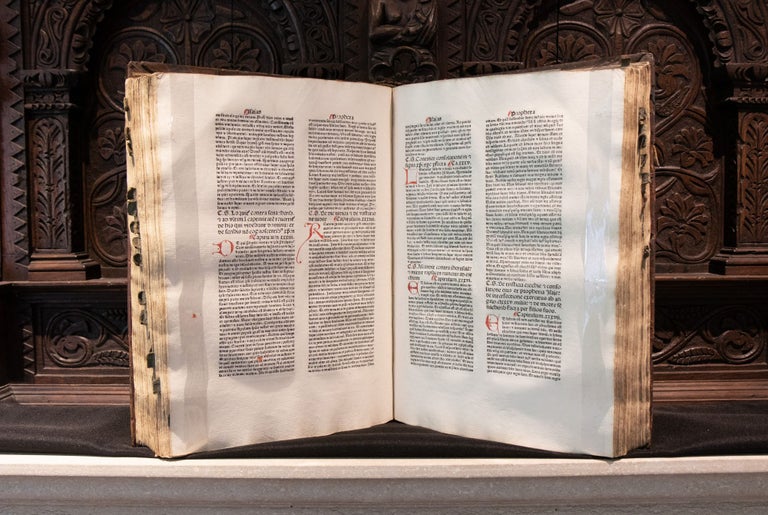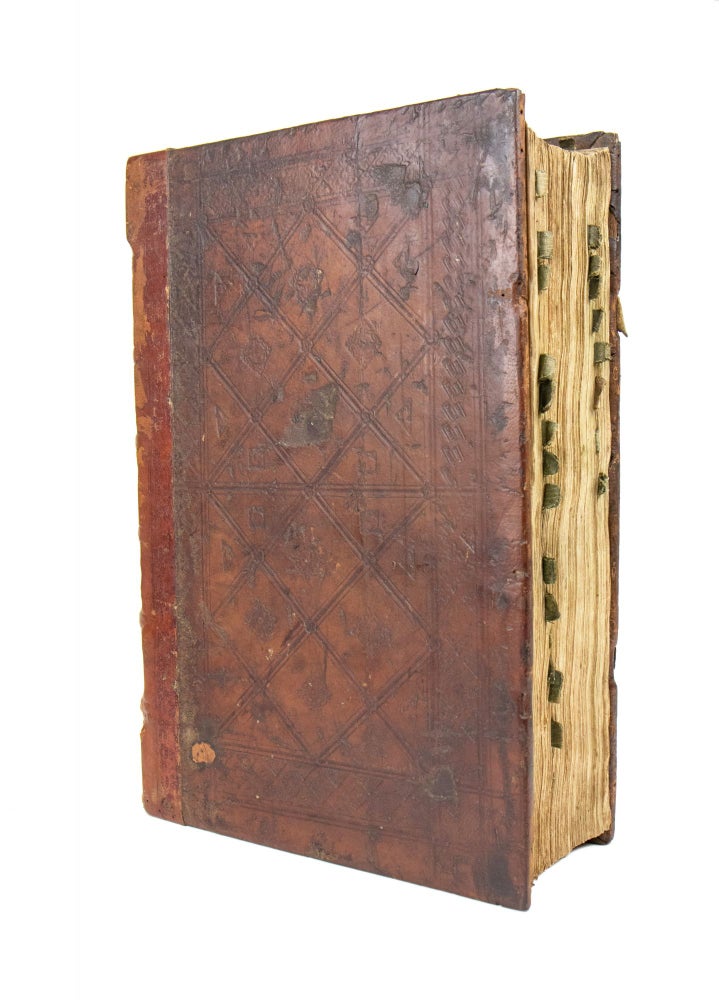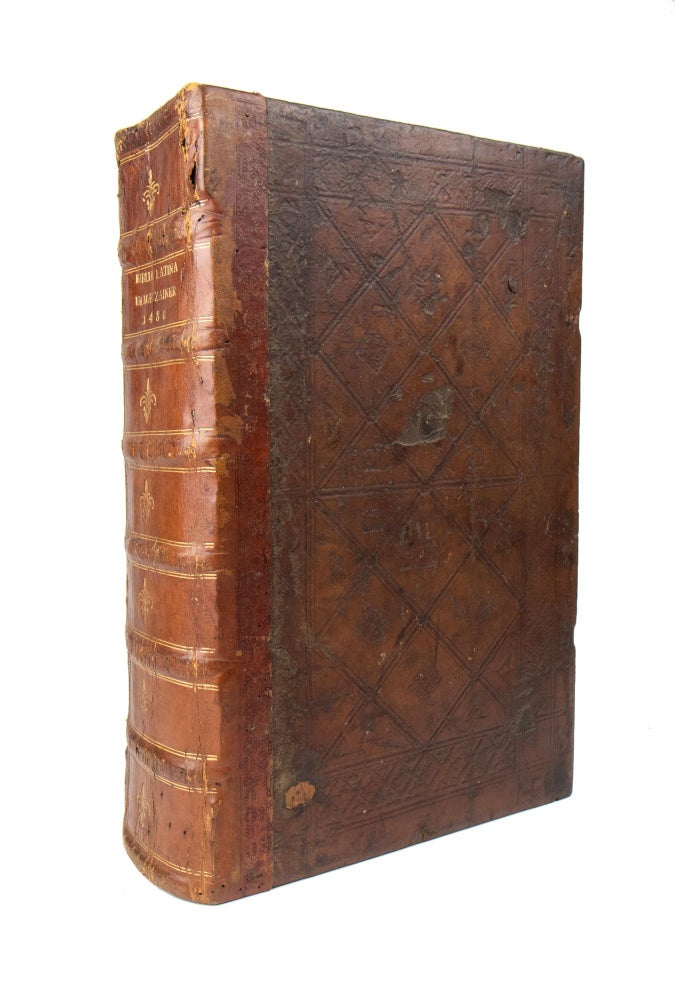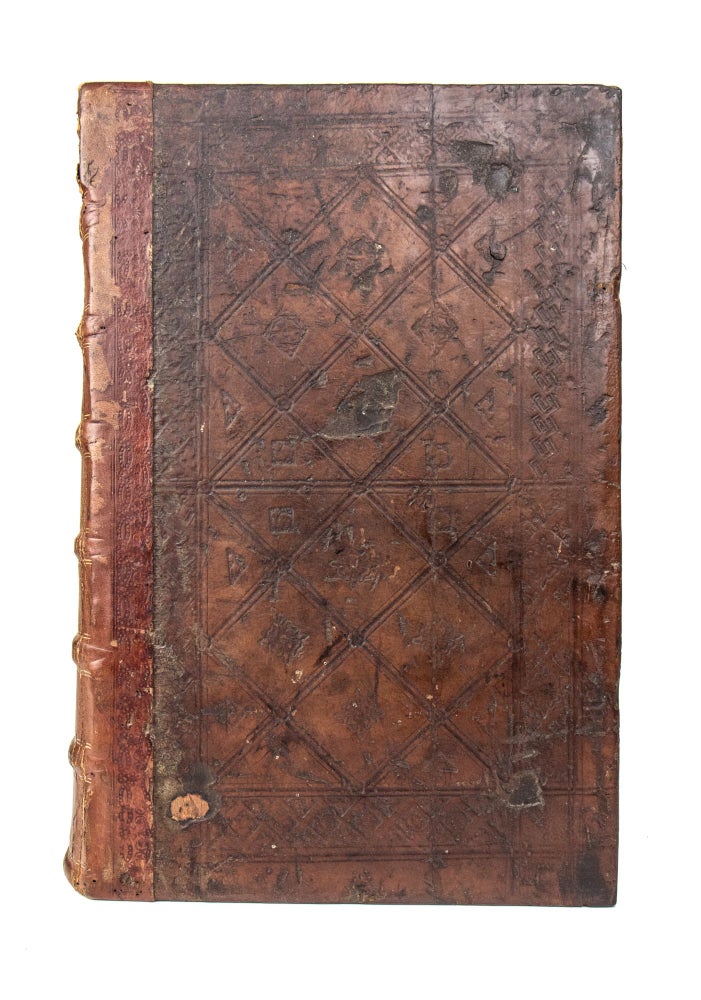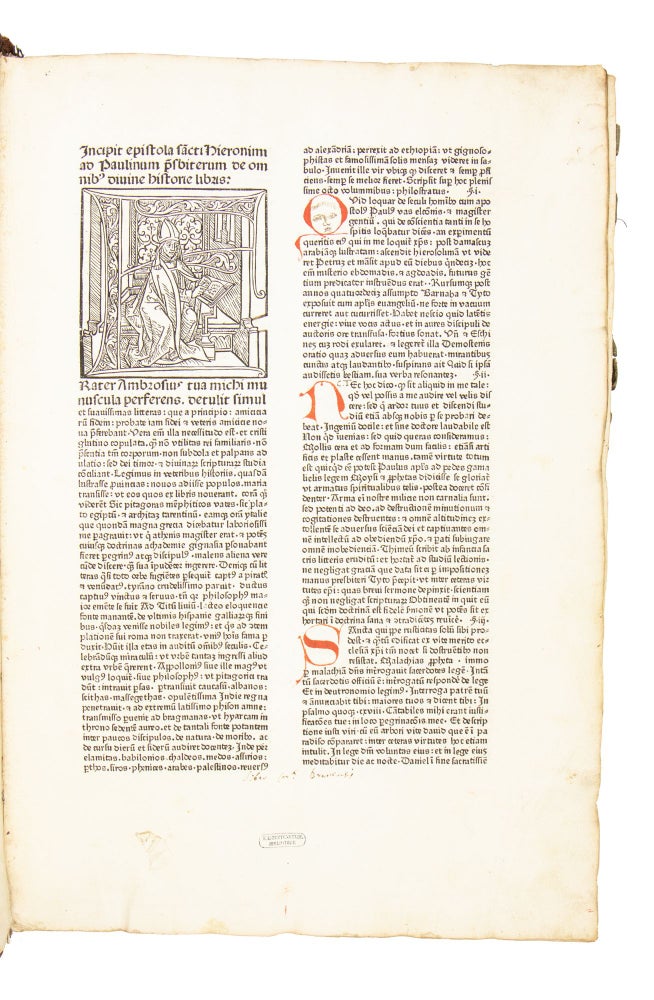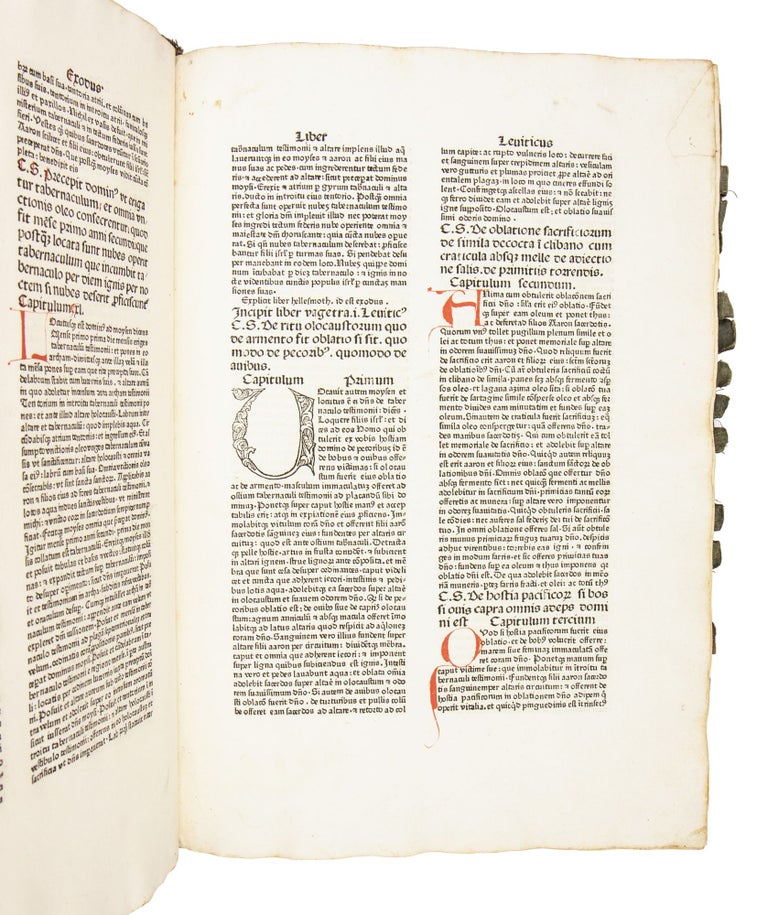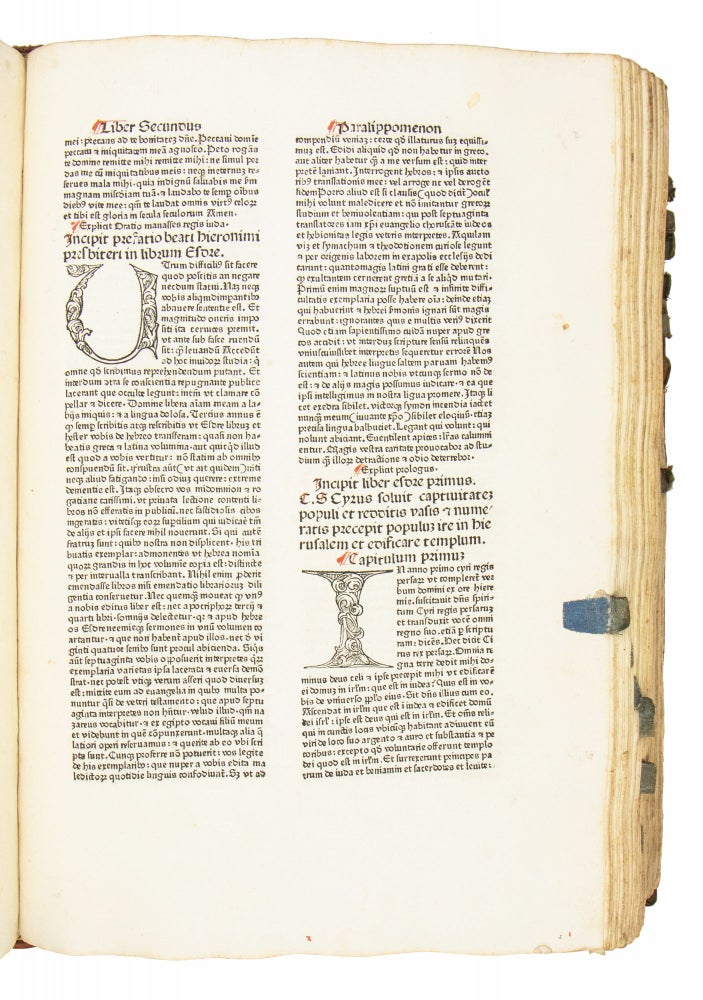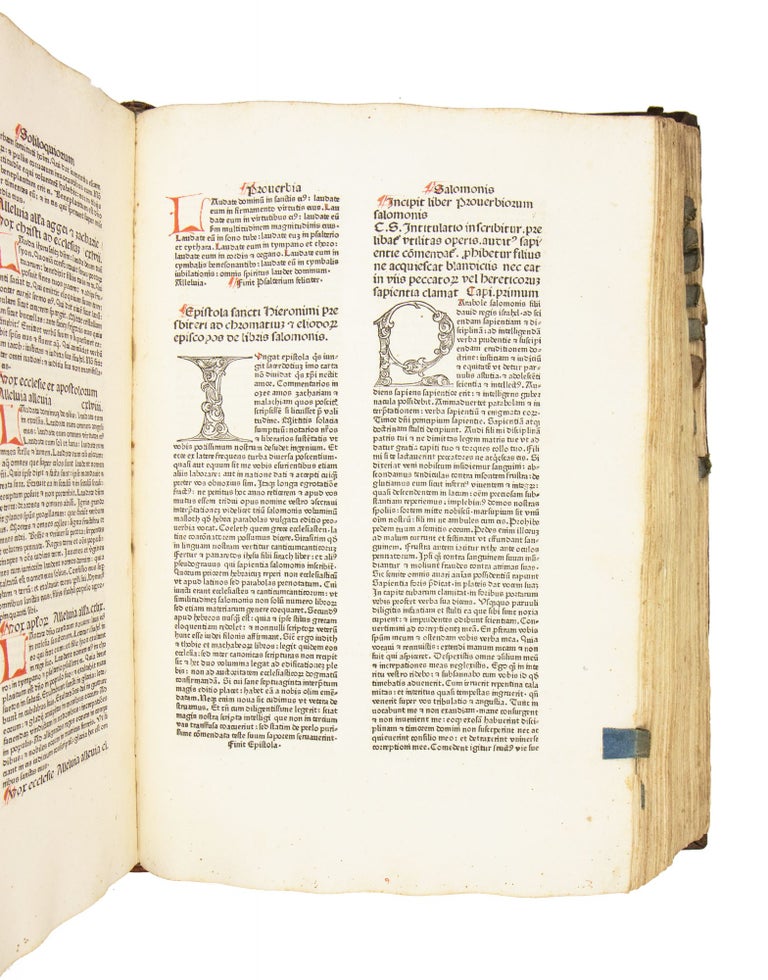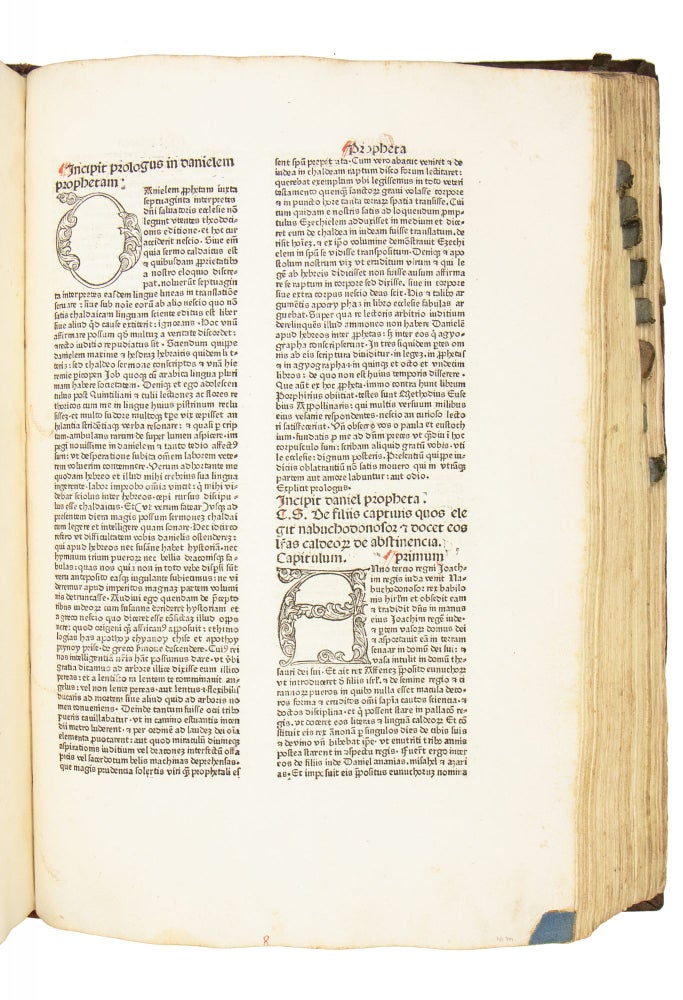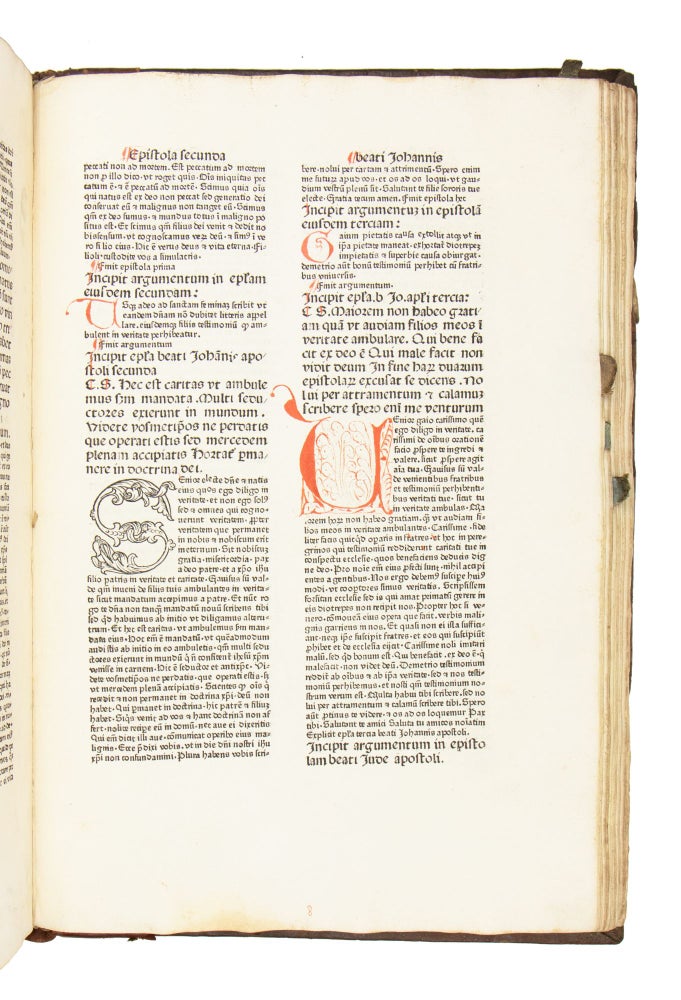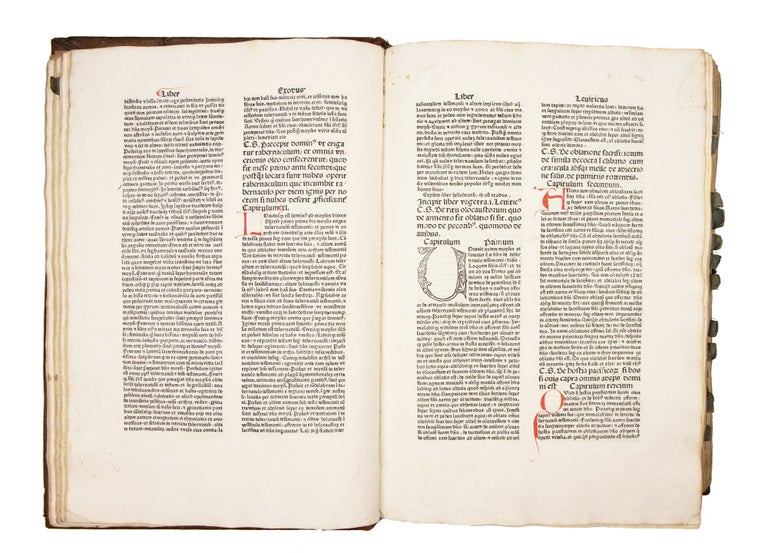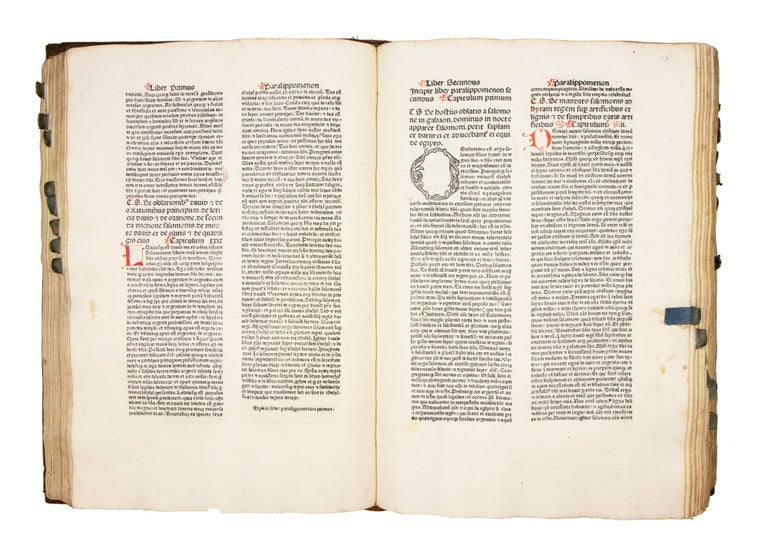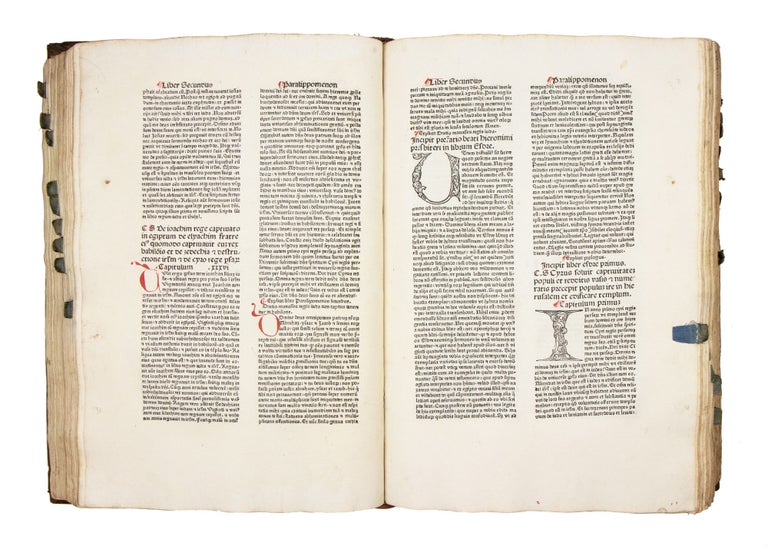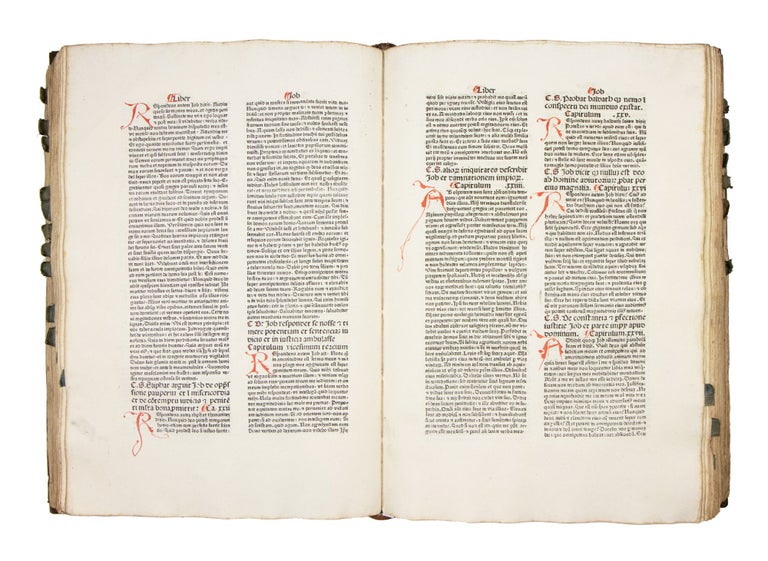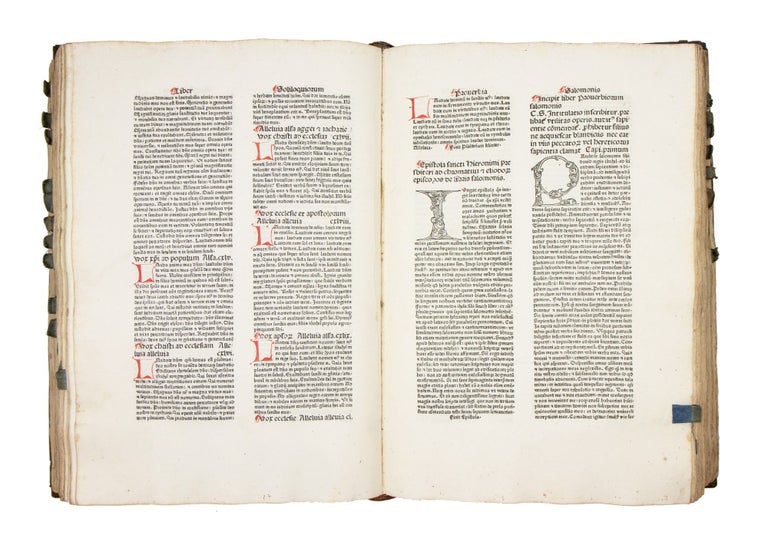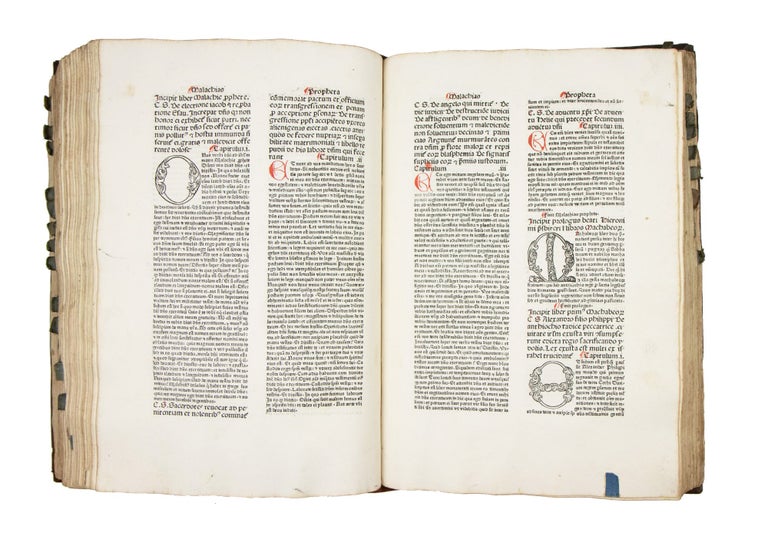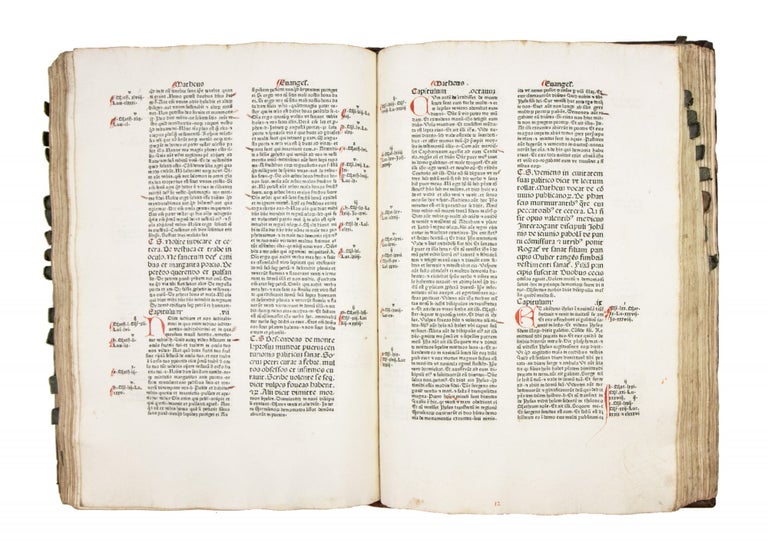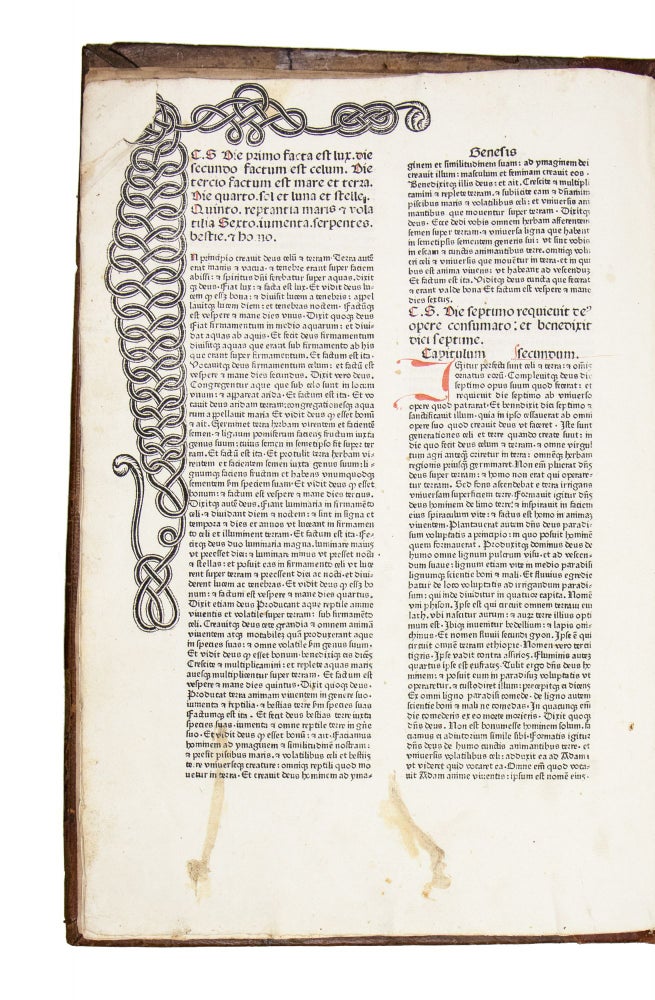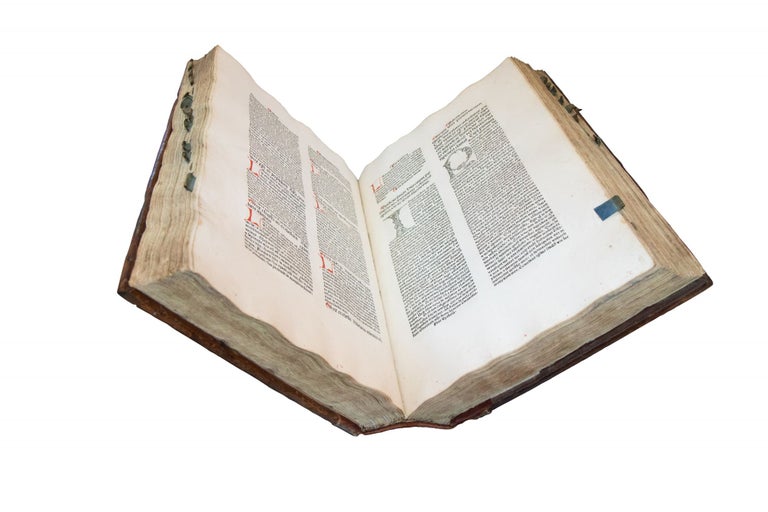Biblia Latina (With printed summaries by Menardus Monachus)
Ulm: Johann Zainer, 29 January, 1480.
Price: $95,000.00
Royal folio: 41.3 x 28 cm. 440 leaves (the first leaf blank and present.) Complete. Collation: A10, b-k8, l10; m-y8; z8, aa-kk8, ll8+1; mm-oo8, pp12; qq-zz8, aaa-ccc8, ddd6+1; *-****8.
FIRST BIBLE PRINTED AT ULM.
An excellent copy, with noble provenance, of this magnificent Bible. A very large, impressive copy, with broad margins, preserving numerous deckled edges. The quires are numbered in a contemporary hand, in red ink, at the foot of leaves. The stub for the canceled blank leaf ll3 (the conjugate of leaf ll9) is visible, with instructions to the binder. With numerous blue fabric tabs, each marking an individual book of the Bible.
Rubricated throughout, with a few larger red brushwork initials and red and blue Lombard capitals, red paragraph marks and capital strokes. The book is adorned with Zainer’s distinctive, large woodcut initials, a larger decorative marginal decoration, and a woodcut of Saint Jerome in his study, working on the Vulgate. on first text leaf (a few corners torn away, one affecting the woodcut decoration in the margin; damp-staining in gutter and lower margin, some light dust-soiling at ends. Occ. natural paper flaws in the blank margins of the paper, (ex. Leaf l8, p3, oo8) not affecting the text.
Bound in contemporary Moravian binding of blindstamped tanned pigskin over wooden boards, nicely rebacked in the mid 19th c., with gilt spine, lacking clasps and catches. The leather of the boards is worn, with small losses to the leather exposing the wooden boards in two places. The richly-tooled binding features tools associated with a workshop that produced bindings for the monastery (see below.) Provenance: 1. With an inscription of the Carthusian monastery of the Holy Trinity, Brno, Moravia (dissolved in 1782). 2. Library of the Princes of Liechtenstein (bookplate), sold in 1949 by Prince Franz Joseph II (1906–1989) to H.P. Kraus. 3. Elaine and Alexandre Rosenberg, acquired from H.P. Kraus, New York, 20 November 1957.
The only Bible printed at Ulm in the 15th century, by Ulm’s first printer, in a contemporary binding. This Bible is illustrated with numerous large, intricate, and unusual woodcut initials. Zainer was likely the brother of Gunther Zainer, first printer at Augsburg. Both men were innovators in printed book illustration. With the Canon of Hebrew names, printed annotations in the margins of the New Testament, and printed summaries at the beginning of each book.
An inscription on the recto of the first blank leaf indicates that this Bible was the property of the Carthusian monastery of the Church of the Holy Trinity in Brno, Moravia in the 15th c. According to Jiøí Glonek (“Knihvazačská dílna královopolských kartuziánů”), the binding was produced in a workshop in Brno, located in a building used by the Carthusians, close to St. Jacob’s church. The bindery existed from the 1460s until 1516 and produced bindings for the monastery as well as St. Jacob’s. Despite the fact that the bindery was located outside of the monastery (unlike the bindery at the Carthusian monastery of Olomouc) Glonek, who has made an in-depth study of the extant bindings, concludes that the bindery was operated by the Carthusians.
At its height, the bindery used over 61 different tools. Among the tools used on the binding of the Ulm Bible are: EBDB s020741 (scroll), EBDB s020731 (dog), EBDB s020720 (Fabelwesen), Glonek 30 (palmette).
The Carthusian monastery at Brno was founded by the Margrave of Moravia, Jan Jindøich, younger brother of the Czech King, Emperor Charles IV. Jindøich invited the first member of the Carthusian order, Gottfried of Enns, from the Austrian Charterhouse in Gaming to Brno as early as 1369, and six years later issued the founding charter of the monastery with the consent of his wife, Elizabeth, and his sons. The foundation charter is dated August 13 1375. The charterhouse was not incorporated into the order until the following year…
“It is understood that the Carthusian library was founded together with the monastery; as of 1387, there is a mention that Jan Czapfel, a chaplain at the Church of St. Jacob in Brno, dedicated his library to the Královo Pole Carthusians. According to this mention, the manuscripts in the collection were donated by Jan Czapfel to the Carthusians even earlier. From the end of the fourteenth century, there was a bookbinding workshop for the monastery, the peak of which dates back to the second half of the fifteenth century.
“[As part of the religious reforms undertaken by Joseph II], the monastery was dissolved by decree on 12 January 1782, along with other monasteries that did not establish a school or a hospital and the brethren of which did not hold a preaching or a priesthood position. The dissolution committee arrived in Moravia six days later… The library, at the time, possessed fewer than 3,000 volumes, including manuscripts and incunabula… [A] total of 145 volumes, including manuscripts and incunabula) were sent to the Imperial Royal Court Library in Vienna after 10 March 1784…
“Books that were not selected for the Court Library in Vienna went to auction, which took place from 7 September 1786 to the end of 1790. We do not know exactly which of the auctions the Carthusian books were sold at, but they probably went to sale at the first September and October auctions in Brno, together with collections from other Brno monastery libraries.(Jindr Pavelková, The Library Collection of the Brno Charterhouse in the Rajhrad Monastery Library, in “Monastic Libraries in East Central and Eastern Europe between the Middle Ages and the Enlightenment”(Monastica Historia Volume 5).
HC 3079*; BMC II 526; BSB-Ink B-438; GW 4242; Bod-inc B-276; Goff B-567; ISTC ib00567000. See also Arthur Hind, An introduction to a history of woodcut (1963), and Claire Bolton, The Fifteenth-century Printing Practices of Johann Zainer, Ulm, 1473-1478 (2016).


